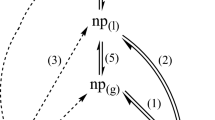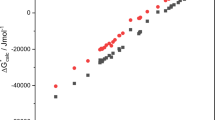Abstract
A protein contains a large amount of water molecules, and the nature of the interactions of the water molecules with a protein play an important role in the thermodynamics of the ligand binding process. In this paper, thermodynamic aspects of drug-receptor interactions, enthalpy-entropy compensation or reinforcement, hydrophobicity, and biological 2D- and 3D-QSAR are discussed. Comparisons of the thermodynamic QSAR of phenyl esters of N-benzoyl L-alanine in phosphate buffer and pentanol provide useful insight for the ligand-enzyme interactions.
Similar content being viewed by others
References
Karplus, P.A. and Faerman, C., Curr. Opinion Struct. Biol., 4 (1994) 770.
Ringe, D., Curr. Opinion Struct. Biol., 5 (1995) 825.
Fitzpatrick, P.A., Steinmetz, A.C.U., Ringe, D. and Klibanov, A.M., Proc. Natl. Acad. Sci. USA, 90 (1993) 8653.
Reslow, M., Adlercreutz, P. and Mattiasson, B., Appl. Microbiol. Biotechnol., 26 (1987) 1.
Stevenson, D.E. and Storer, A.C., Biotechnol. Bioeng., 37 (1991) 519.
Allen, K.N., Bellamacina, C.R., Ding, X., Jeffery, C.J., Mattos, C., Petsko, G.A. and Ringe, D., J. Phys. Chem., 100 (1996) 2605.
Kim, K.H., Greco, G. and Novellino, E., in Kubinyi, H., Golkers, G. and Martin, Y.C. (Eds) A Critical Review on Recent CoMFA Applications. 3D QSAR in Drug Design. Recent Advances, Vol. 3. Kluwer Academic Publishers, Dordrecht, 1998, pp. 257-315.
Martin, Y.C., Kim, K.H. and Lin, C.T., in Charton, M. (ed.), Comparative Molecular Field Analysis: CoMFA. Advances in Quantitative Structure-Property Relationships, Vol. 1. JAI Press Inc., Greenwich, Connecticut, 1996, pp. 1-52.
Bohm, H.-J. and Klebe, G., Angew. Chem. Int. Ed. Engl., 35 (1996) 2588.
Cramer, R.D. III, Patterson, D.E. and Bunce, J.D., J. Am. Chem. Soc., 110 (1988) 5959.
Gilli, P., Ferretti, V., Gilli, G. and Borea, P.A., J. Phys. Chem., 98 (1994) 1515.
Hitzemann, R., TIPS, 9 (1988) 408.
Leffler, J.E. and Grunwald, E., Rates and Equilibria of Organic Reactions. Wiley, New York, NY, 1963.
Sleigh, S.H., Seavers, P.R., Wilkinson, A.J., Ladbury, J.E. and Tame, J.R.H., J. Mol. Biol., 291 (1999) 393.
Dunitz, J.D., Chem. Biol., 2 (1995) 709.
Lemieux, R.U., Acc. Chem. Res., 29 (1996) 373.
Rogers, J.A. and Wong, A., J. Pharm., 6 (1980) 339.
Gallicchio, E., Kubo, M.M. and Levy, R.M., J. Am. Chem. Soc., 120 (1998) 4526.
Krug, R.R., Hunter, W.G. and Grieger, R.A., Nature, 261 (1976) 566.
Krug, R.R., Hunter, W.G. and Grieger, R.A., J. Phys. Chem., 80 (1976) 2335.
Krug, R.R., Hunter, W.G. and Grieger, R.A., J. Phys. Chem., 80 (1976) 2341.
Da, Y.-Z., Ito, K. and Fujiwara, H., J. Med. Chem., 35 (1992) 3382.
Nakamura, K., Hayashi, K., Ueda, I. and Fujiwara, H., Chem. Pharm. Bull., 43 (1995) 369.
Selassie, C.D., Gan, W.X., Fung, M. and Shortle, R., in Sanz, J.G.F. and Manaut, F. (eds), Chymotrypsin-ligand interactions in non-aqueous solvents. QSAR and Molecular Modelling: Concepts, Computational Tools and Biological Applications, Proceedings of the 10th European Symposium on Structure-Activity Relationships: QSAR and Molecular Modelling, Barcelona, September 4-9, 1994. J. R. Pros Science Publishers, Barcelona, 1994, pp. 128-130.
Kim, K.H., Bioorg. Med. Chem., 9 (2001) in press.
Blaney, J.M. and Hansch, C., in Ramsden, C.A. (ed.), Application of Molecular Graphics to the Analysis of Macromolecular Structures. Quantitative Drug Design. Pergamon, Oxford, 1990, pp. 459-496.
Compadre, C.M., Sanzhez, R.I., Bhuvaneswaran, C., Compadre, R.L., Plunkett, D. and Novick, S.G., in Wermuth, C.G. (ed.), Analysis of enzyme-ligand interactions in organic solvents: A QSAR approach. Trends in QSAR and Molecular Modelling 92, Proceedings of the 9th European Symposium on Structure-Activity Relationships: QSAR and Molecular Modeling. September 7-11, 1992, Strasbourg, France. ESCOM, Leiden, 1993, pp. 112-115.
Leo, A.J., Chem. Rev., 93 (1993) 1281.
Greco, G., Novellino, E. and Martin, Y.C., in Martin, Y.C. and Willet, P. (eds), Approaches to Three-Dimensional Quantitative Structure-Activity Relationships. Designing Bioactive Molecules: Three-Dimensional Techniques and Applications. American Chemical Society, Washington, DC, 1997, pp. 219-252.
Kim, K.H., in Dean, P.M. (ed.), Comparative Molecular Field Analysis (CoMFA). Molecular Similarity in Drug Design. Blackie Academic & Professional, London, 1995, pp. 291-331.
Abraham, D.J. and Kellogg, G.E., in Kubinyi, H. (ed.), Hydrophobic Fields. 3D QSAR in Drug Design. Theory Methods and Applications. ESCOM, Leiden, 1993, pp. 506-522.
Kim, K.H., Med. Chem. Res., 1 (1991) 259.
Cramer III, R.D., DePriest, S.A., Patterson, D.E. and Hecht, P., in Kubinyi, H. (ed.), The Developing Practice of Comparative Molecular Field Analysis. 3D QSAR in Drug Design. ESCOM, Leiden, 1993, pp. 443-485.
GRID program. Molecular Discovery Ltd., West Way House, Elms Parade, Oxford, U.K.
Kim, K.H., Quant. Struct.-Act. Relat., 12 (1993) 232.
Waller, C.L., Quant. Struct.-Act. Relat., 13 (1994) 172.
Kim, K.H., in Kubinyi, H. (ed.), Comparison of Classical and 3D QSAR. 3D QSAR in Drug Design. Theory Methods and Applications. ESCOM, Leiden, 1993, pp. 619.
Klebe, G. and Abraham, U., J. Med. Chem., 36 (1993) 70.
Steinmetz, W.E., Quant. Struct.-Act. Relat., 15 (1996) 1.
Wade, R.C., in Kubinyi, H. (ed.), Molecular Interaction Fields. 3D QSAR in Drug Design. ESCOM, Leiden, 1993, pp. 486-506.
Kim, K.H., Quant. Struct.-Act. Relat., 11 (1992) 127. 380
Kim, K.H., Greco, G., Novellino, E., Silipo, C., Vittoria, A., J. Comput. Aided Mol. Des., 7 (1993) 263.
Kim, K.H., in Wermuth, C.G. (ed.), Use of the hydrogen-bond potential function on comparative molecular field analysis (CoMFA): An extension of CoMFA. Trends in QSAR and Molecular Modelling 92, Proceedings of the 9th European Symposium on Structure-Activity Relationships: QSAR and Molecular Modelling. September 7-11, 1992, Strasbourg, France. ESCOM, Leiden, 1993, pp. 245-251.
Klebe, G. and Abraham, U., J. Med. Chem., 36 (1993) 70.
Steinmetz, W.E., Quant. Struct. Act. Relat., 15 (1996) 1.
Wade, R.C., in Kubinyi, H. (ed.), Molecular interaction fields. 3D QSAR in Drug Design. Theory Methods and Applications. ESCOM, Leiden, 1993, pp. 486-506.
Kim, K.H., J. Comput.-Aid. Mol. Design, 9 (1995) 308.
Kim, K.H. and Kim, D.H., Bioorg. Med. Chem., 3 (1995) 1389.
Author information
Authors and Affiliations
Rights and permissions
About this article
Cite this article
Kim, K.H. Thermodynamic aspects of hydrophobicity and biological QSAR. J Comput Aided Mol Des 15, 367–380 (2001). https://doi.org/10.1023/A:1011163527770
Issue Date:
DOI: https://doi.org/10.1023/A:1011163527770




